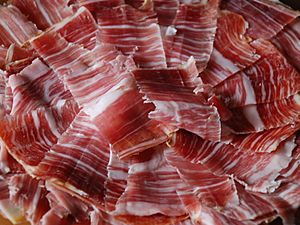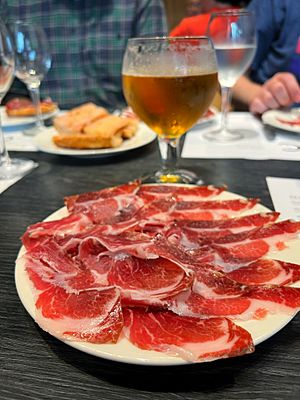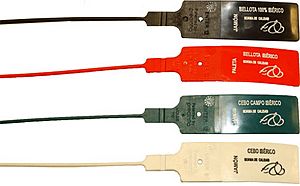Jamón ibérico facts for kids

Jamón Ibérico
|
|
| Alternative names | Pata negra, Jabugo |
|---|---|
| Place of origin | Spain, Portugal |
| Main ingredients | Ham |
| Variations | Jamón serrano |
Jamón ibérico is a special type of ham from Spain and Portugal. It's also known as "Iberian ham." This delicious ham comes from a unique kind of pig called the Black Iberian pig. These pigs are raised in a specific way to make the ham taste amazing.
Contents
What is Jamón Ibérico?
Jamón ibérico is a dry-cured ham. This means it's preserved using salt and then dried for a long time. To be called ibérico, the ham must come from Black Iberian pigs. These pigs can be purebred or at least 50% Black Iberian, mixed with Duroc pigs.
This ham is known for its smooth texture and rich, savory taste. It often has a lot of fat mixed into the meat, which makes it very flavorful. This fat is called marbling.
Where Does it Come From?
The Iberian Pig's Home
The special black Iberian pig mainly lives in the central and southwestern parts of the Iberian Peninsula. This area includes both Portugal and Spain. In Spain, you'll find these pigs in places like Huelva, Córdoba, and Salamanca. In Portugal, they are common in the Alentejo region. People in Portugal often call them porco preto ibérico. There are even festivals to celebrate these pigs!
How Jamón Ibérico is Made

After baby pigs stop drinking milk, they are fed barley and corn for a few weeks. Then, they get to roam freely in pastures and oak forests. Here, they eat natural foods like grass, herbs, acorns, and roots. For the very best jamón ibérico, the pigs eat only acorns or chestnuts before they are ready.
After the pigs are ready, their legs are salted. They dry for about two weeks. Then, they are rinsed and left to dry for another four to six weeks. The final drying process, called curing, takes at least 12 months. Some hams cure for up to 48 months! During this time, the meat dries in salt. This helps stop bad germs from growing. The ham is then hung up, and a layer of mold grows on the outside. This mold helps protect the meat inside.
Keeping Jamón Ibérico Fresh
You can buy jamón ibérico already sliced and sealed in a package. This vacuum-packed ham can last for about 100 days at room temperature. This is because the packaging keeps air out.
If you buy a whole leg of ham, it won't last as long once it's opened. If you cut it regularly and cover it, an opened leg can last for three months. It's not a good idea to freeze jamón ibérico. Freezing can damage the meat's fibers and change its delicious taste.
How Jamón Ibérico is Graded
Hams are given special labels based on what the pigs ate. They are also graded by how much Black Iberian pig ancestry they have. The best hams come from purebred pigs that ate only acorns. A new color-coded labeling system started in 2014.
- Black-label - jamón 100% ibérico de bellota (acorn). This is the highest quality. It comes from purebred Iberian pigs. These pigs roam in oak forests and eat only acorns during their last feeding period. The ham is cured for 36 months.
- Red-label - jamón ibérico de bellota (acorn). This ham also comes from free-range pigs that eat acorns. However, these pigs are not purebred. The label shows if they are 75% or 50% Iberian pig.
- Green-label - jamón ibérico cebo de campo. This ham comes from pigs that live in pastures. They eat a mix of acorns and grain. These pigs can be 100%, 75%, or 50% Iberian.
- White-label - jamón ibérico de cebo. This ham comes from pigs that eat only grain. It is cured for 24 months. These pigs can also be 100%, 75%, or 50% Iberian.
A few important things to know:
- The term pata negra (which means "black foot") is now only used for the best black-label jamón ibérico. This term used to be used for any good ham, but now it's only for the very best. It refers to the black hoof of the Black Iberian pig.
- The word puro (pure) can be added to labels. This means both parents of the pig were purebred Iberian pigs.
- Pictures of acorns and oak forests can only be on labels for bellota hams.
Famous Producers and Protected Names
Many places in Spain and Portugal are famous for making Jamón ibérico. Their names are protected by law. This means only ham made in these specific areas can use these names.
- D.O.P. Guijuelo: This ham comes from pigs raised in the mountains of Castile and León and Extremadura. The main town for this ham is Guijuelo. About 60% of all Jamón ibérico comes from this area.
- D.O.P. Jabugo: This ham is made in the Sierra de Aracena and Picos de Aroche Natural Park in Huelva. The whole town of Jabugo is dedicated to making jamón ibérico.
- D.O.P. Dehesa de Extremadura: This ham comes from pigs raised in the oak forests of Extremadura. This region has huge areas of these special forests.
- D.O.P. Los Pedroches: This ham comes from the province of Córdoba. It has a special V-shape cut. The meat is pink to red-purple with fat mixed in.
Why Jamón Ibérico is So Popular
Ibérico ham is one of the most expensive hams in the world. Its fatty, marbled texture makes it a highly desired food. Many people around the world want to try it.
In 2017, people in Spain ate about 13,000 metric tons of jamón ibérico. This led to about 4 billion euros in sales! The demand for this ham keeps growing. However, it's hard to make more because the special way it's produced takes time and care. This means the price of jamón ibérico is going up.
Because jamón ibérico is so special and limited, it's important to be careful when buying it. Sometimes, products are sold as ibérico when they are not truly the real thing.
Jamón Ibérico in the United States
Before 2005, it was hard to get jamón ibérico in the United States. This was because of rules about pig diseases. In 2005, the first Spanish slaughterhouse was approved to send ibérico products to the U.S. The first jamones ibéricos were sold in the United States in December 2007. The special bellota hams followed in July 2008.
Images for kids
-
The town of Jabugo is famous for making Jamón ibérico.
ja:ハモン・イベリコ ru:Хамон (блюдо)
See also
 In Spanish: Jamón ibérico para niños
In Spanish: Jamón ibérico para niños





